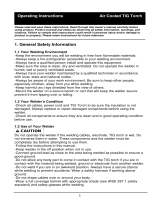
Effective January 1, 2019
(Equipment with a serial number preface of MK or newer)
This limited warranty supersedes all previous Miller warranties and is exclusive with no other
guarantees or warranties expressed or implied.
LIMITED WARRANTY − Subject to the terms and conditions
below, Miller Electric Mfg. LLC, Appleton, Wisconsin and ITW
Welding (hereafter referred to as Miller) warrant to authorized
distributors that new Miller equipment sold after the effective
date of this limited warranty is free of defects in material and
workmanship at the time it is shipped by Miller. THIS
WARRANTY IS EXPRESSLY IN LIEU OF ALL OTHER
WARRANTIES, EXPRESS OR IMPLIED, INCLUDING THE
WARRANTIES OF MERCHANTABILITY AND FITNESS.
Within the warranty periods listed below, Miller will repair or
replace any warranted parts or components that fail due to such
defects in material or workmanship. Miller must be notified in
writing within thirty (30) days of such defect or failure, at which
time Miller will provide instructions on the warranty claim
procedures to be followed. Notifications submitted as online
warranty claims must provide detailed descriptions of the fault
and troubleshooting steps taken to diagnose failed parts.
Warranty claims that lack the required information as defined in
the Miller Service Operation Guide (SOG) may be denied by
Miller.
Miller shall honor warranty claims on warranted equipment
listed below in the event of a defect within the warranty
coverage time periods listed below. Warranty time periods start
on the delivery date of the equipment to the end-user
purchaser, or 18 months after the equipment is shipped to an
International distributor, whichever occurs first.
1. 5 Years Parts — 3 Years Labor
* Original Main Power Rectifiers Only to Include
SCRs, Diodes, and Discrete Rectifier Modules
2. 3 Years — Parts and Labor Unless Specified
* Auto-Darkening Helmet Lenses (No Labor) (See
Classic Series Exception Below)
* Engine Driven W
elder/Generators
(NOTE: Engines are Warranted Separately by the
Engine Manufacturer.)
* Insight Welding Intelligence Products
* Inverter Power Sources
* Plasma Arc Cutting Power Sources
* Process Controllers
* Semi-Automatic and Automatic Wire Feeders
* Transformer/Rectifier Power Sources
3. 2 Years — Parts and Labor
* Auto-Darkening Helmet Lenses – Classic Series
Only
(No Labor)
* Auto-Darkening Weld Masks (No Labor)
* Fume Extractors − Capture 5, Filtair 400 and
Industrial
Collector Series
4. 1 Year — Parts and Labor Unless Specified
* AugmentedArc and LiveArc Welding Systems
* Automatic Motion Devices
* Bernard BTB Air-Cooled MIG Guns (No Labor)
* CoolBelt and CoolBand Blower Unit (No Labor)
* Desiccant Air Dryer System
* Field Options
(NOTE: Field options are covered for the
remaining warranty period of the product they
are installed in, or for a minimum of one year —
whichever is greater.)
* RFCS Foot Controls (Except RFCS-RJ45)
* Fume Extractors − Filtair 130, MWX and SWX Series
* HF Units
* ICE/XT Plasma Cutting Torches (No Labor)
* Induction Heating Power Sources, Coolers
(NOTE: Digital Recorders are Warranted
Separately
by the Manufacturer.)
* Load Banks
* Motor-Driven Guns (except Spoolmate Spoolguns)
* PAPR Blower Unit (No Labor)
* Positioners and Controllers
* Racks (For Housing Multiple Power Sources)
* Running Gear/Trailers
* Spot Welders
* Subarc Wire Drive Assemblies
* TIG Torches (No Labor)
* Tregaskiss Guns (No Labor)
* Water Cooling Systems
* Wireless Remote Foot/Hand Controls and
Receivers
* Work Stations/Weld Tables (No Labor)
5. 6 Months — Parts
* Batteries
6. 90 Days — Parts
* Accessories (Kits)
* Canvas Covers
* Induction Heating Coils and Blankets, Cables, and
Non-Electronic Controls
* M-Guns
* MIG Guns, Subarc (SAW) Torches, and External
Cladding Heads
* Remote Controls and RFCS-RJ45
* Replacement Parts (No labor)
* Spoolmate Spoolguns
Miller’s True Blue® Limited Warranty shall not apply to:
1.
Consumable
components; such as contact tips,
cutting nozzles, contactors, brushes, relays, work
station table tops and welding curtains, or parts
that fail due to normal wear. (Exception: brushes
and relays are covered on all engine-driven
products.)
2. Items furnished by Miller, but manufactured by others,
such as engines or trade accessories. These items are
covered by the manufacturer’s warranty, if any.
3. Equipment that has been modified by any party other
than Miller, or equipment that has been improperly
installed,
improperly operated or misused based upon
industry standards, or equipment which has not had
reasonable
and necessary maintenance, or equipment
which has been used for operation outside of the
specifications
for the equipment.
4. Defects caused by accident, unauthorized repair, or
improper testing.
MILLER PRODUCTS ARE INTENDED FOR COMMERCIAL
AND INDUSTRIAL USERS TRAINED AND EXPERIENCED IN
THE USE AND MAINTENANCE OF WELDING EQUIPMENT.
The exclusive remedies for warranty claims are, at Miller’s
option, either: (1) repair; or (2) replacement; or, if approved
in writing by Miller, (3) the pre-approved cost of repair or
replacement
at an authorized Miller service station; or (4)
payment of or credit for the purchase price (less reasonable
depreciation
based upon use). Products may not be
returned without Miller’s written approval. Return shipment
shall be at customer’s risk and expense.
The above remedies are F.O.B. Appleton, WI, or Miller’s
authorized
service facility. Transportation and freight are the
customer’s responsibility. TO THE EXTENT PERMITTED
BY LAW, THE REMEDIES HEREIN ARE THE SOLE AND
EXCLUSIVE REMEDIES REGARDLESS OF THE LEGAL
THEORY. IN NO EVENT SHALL MILLER BE LIABLE FOR
DIRECT, INDIRECT, SPECIAL, INCIDENTAL OR
CONSEQUENTIAL
DAMAGES (INCLUDING LOSS OF
PROFIT) REGARDLESS OF THE LEGAL THEORY. ANY
WARRANTY NOT PROVIDED HEREIN AND ANY IMPLIED
WARRANTY, GUARANTY, OR REPRESENTATION,
INCLUDING ANY IMPLIED WARRANTY OF
MERCHANTABILITY OR FITNESS FOR PARTICULAR
PURPOSE, ARE EXCLUDED AND DISCLAIMED BY
MILLER.
This Limited Warranty provides specific legal rights, and
other rights may be available, but may vary by country.
Warranty Questions?
Call your ITW Welding
Regional Office.
mil int warr 2019-01






















